The fourth instalment in this comprehensive series on the origins of the Shinkasen! This covers a series of photographs of the line’s construction between Tokyo and Osaka, with the former and latter stations well represented, as seen during 1963. There’s also some detail about the construction of the New Tanna Tunnel on which work had started back in 1959. In Tokyo itself it certainly wasn’t an easy job to build the new line as the new alignment took up a thin ribbon alongside the existing railways and sections suspended above the city’s streets had to be employed. Part of the high speed rail route in the city was built alongside the new network of motorways the country had planned for the 1964 Olympics.
The line’s construction at various locations
The Tokaido Shinkansen was originally intended to terminate at Osaka station itself however many technicalities with that idea (plus any possibility of extending the new Tokaido Line further west) meant a different location had to be chosen. Another option considered was a terminus at Higashi-Yodogawa station, a short distance to the north of the current Shin Osaka station. Like several other options for new stations on the Shinkansen, the land available was too small so that was also rejected. Fortunately the nearby Miyahara train yards were a prime site because of its size and immediate availability. As it was already owned by the Japanese National Railways this became the site for Shin Osaka station. Construction of Shin Osaka station also provided for any possible extension westwards

Model of the proposed New Osaka station. It seems the gardens and statue shown here were not built and the space given over to car parking instead. Source: Atamatote Blog

Shin-Osaka (New Osaka) station under construction 1962. This initial steel frame would eventually become the new Shinkansen station sited above the narrow gauge railway tracks. A substantial interchange would be established here. Source: Railway in Memory

The lengthy Hinode viaduct under construction on the approaches to Shin-Osaka station. Source: Railway in Memory
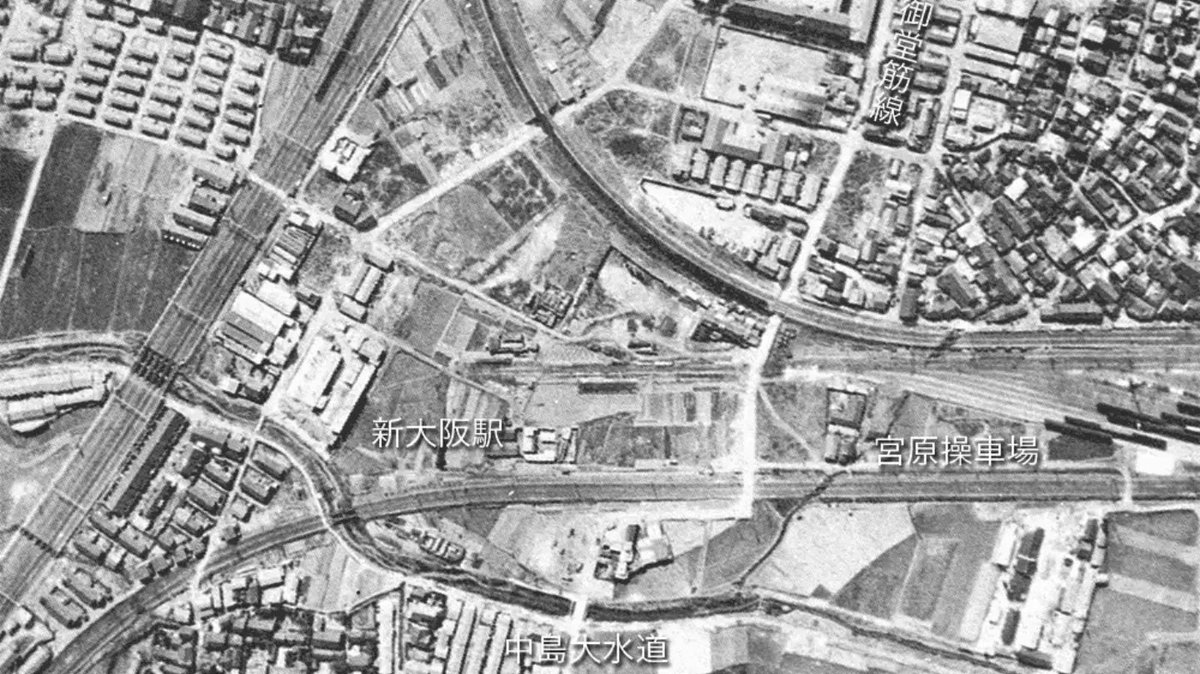
The Miyahara train yards site before Shin-Osaka station was built. Source: Twitter
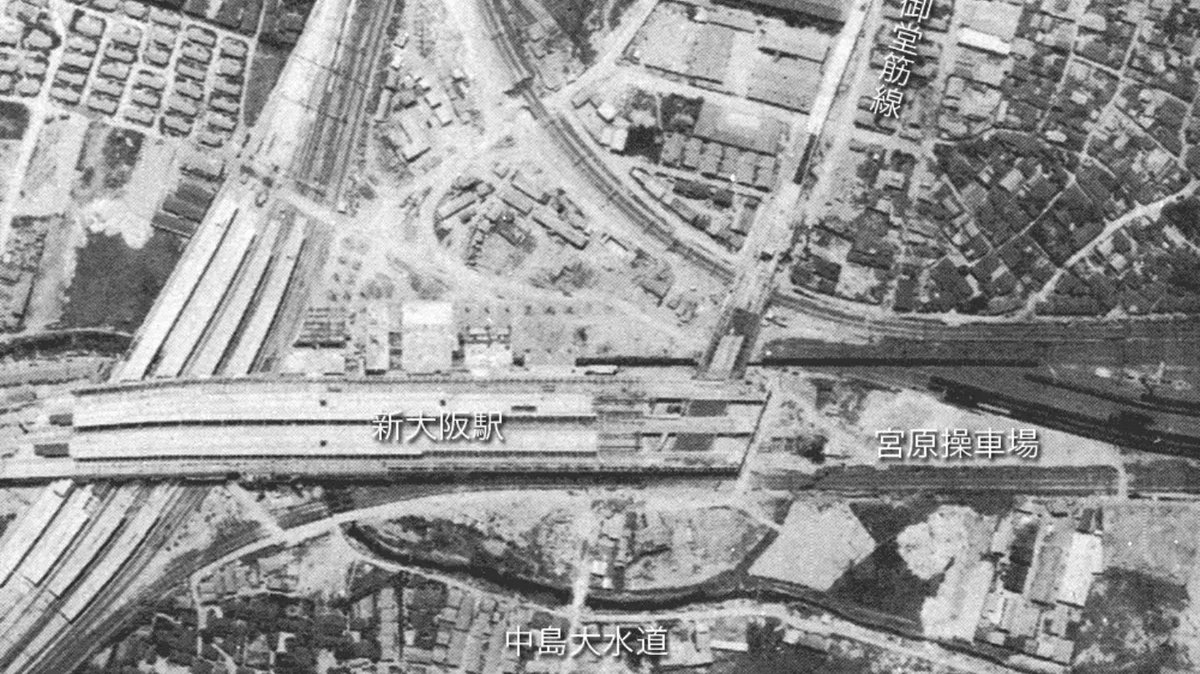
The same location at Miyahara train yards with Shin-Osaka station under construction. Source: Twitter
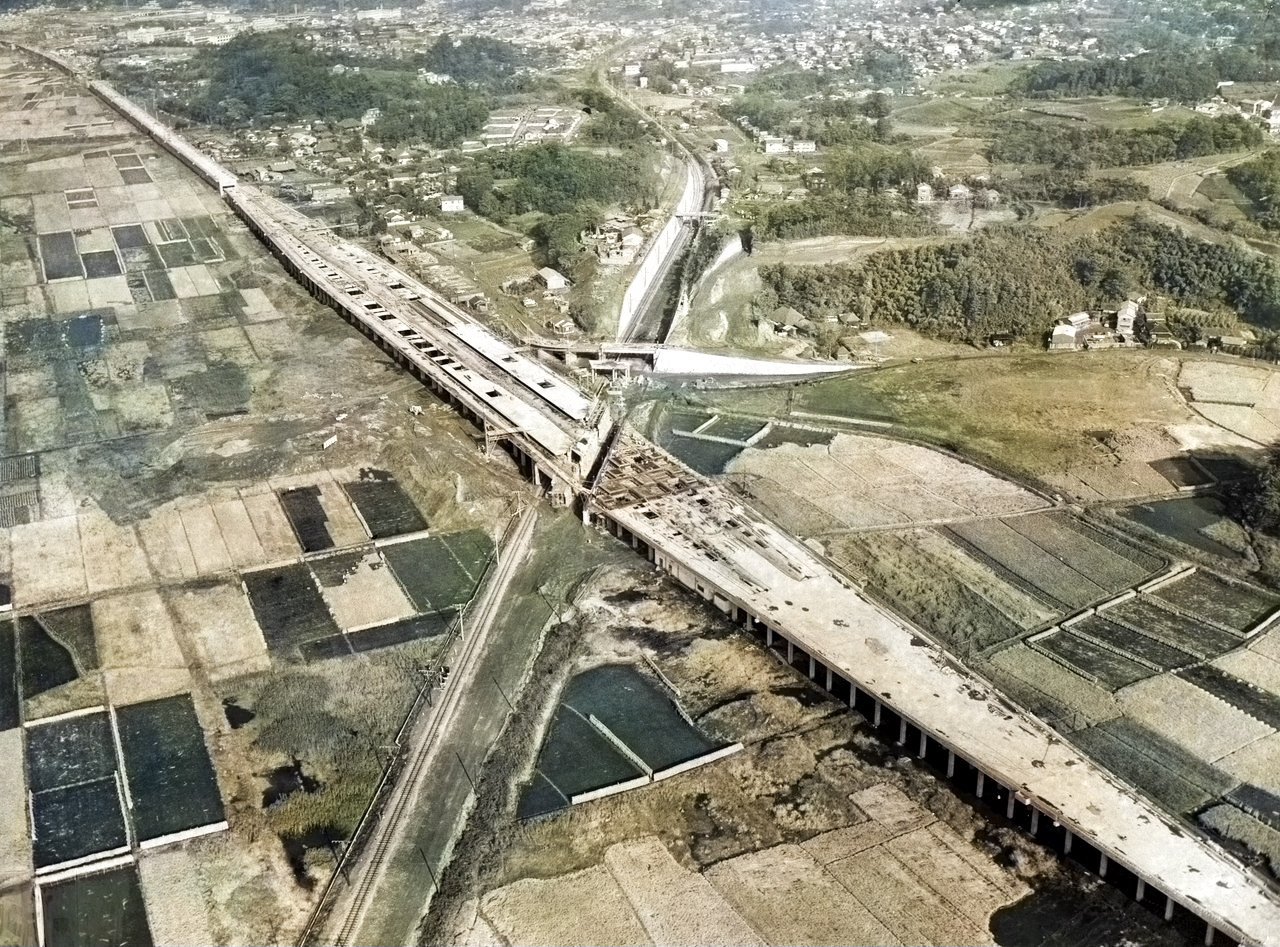
Shin-Yokohama under construction, 1963. Source: Twitter
Meanwhile in Tokyo, the subject of the 1964 Olympics, there was a lot of reconstruction and new buildings happening. The course of the Shinkansen within the city had to be built through a very narrow profile – even the new motorways built at the time got more space!
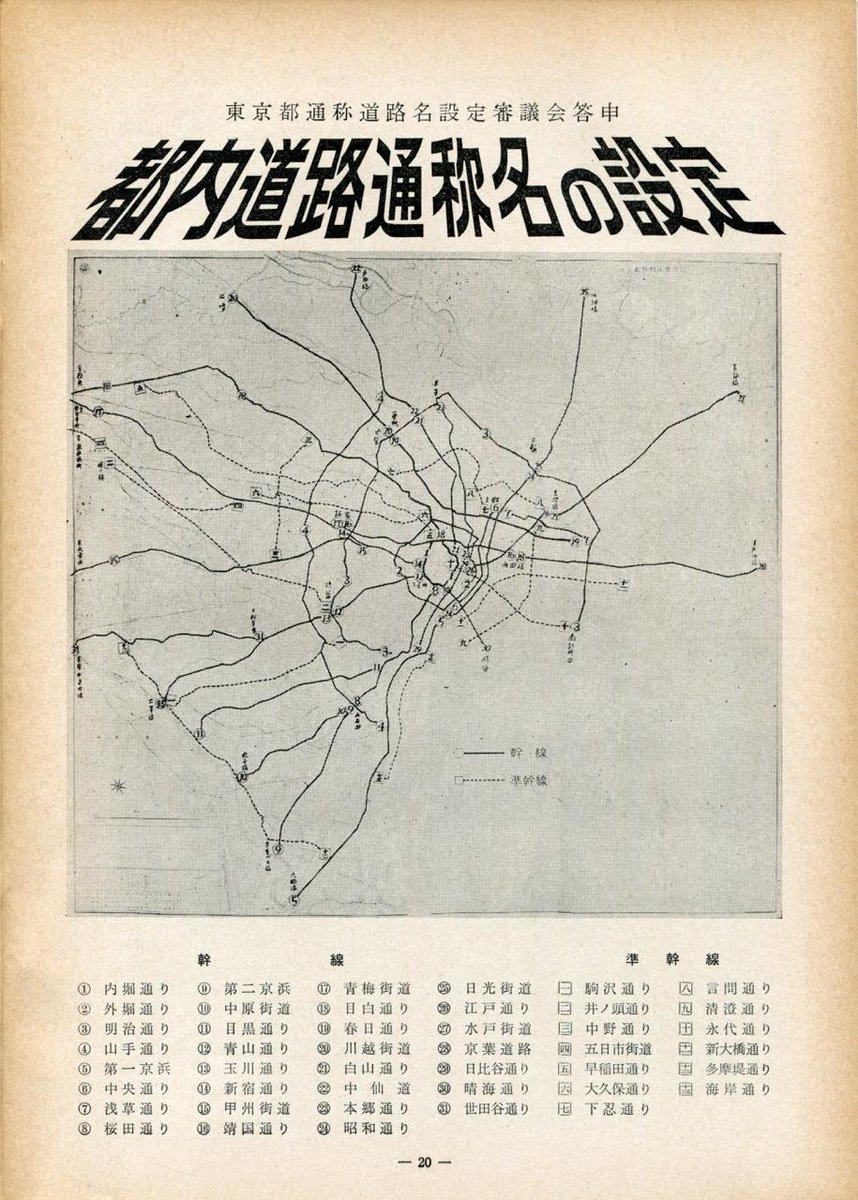
As this document shows, many new roads were built in the city for 1964. Within this mass network of new transport arteries, just one railway and one monorail was built. Source: Twitter
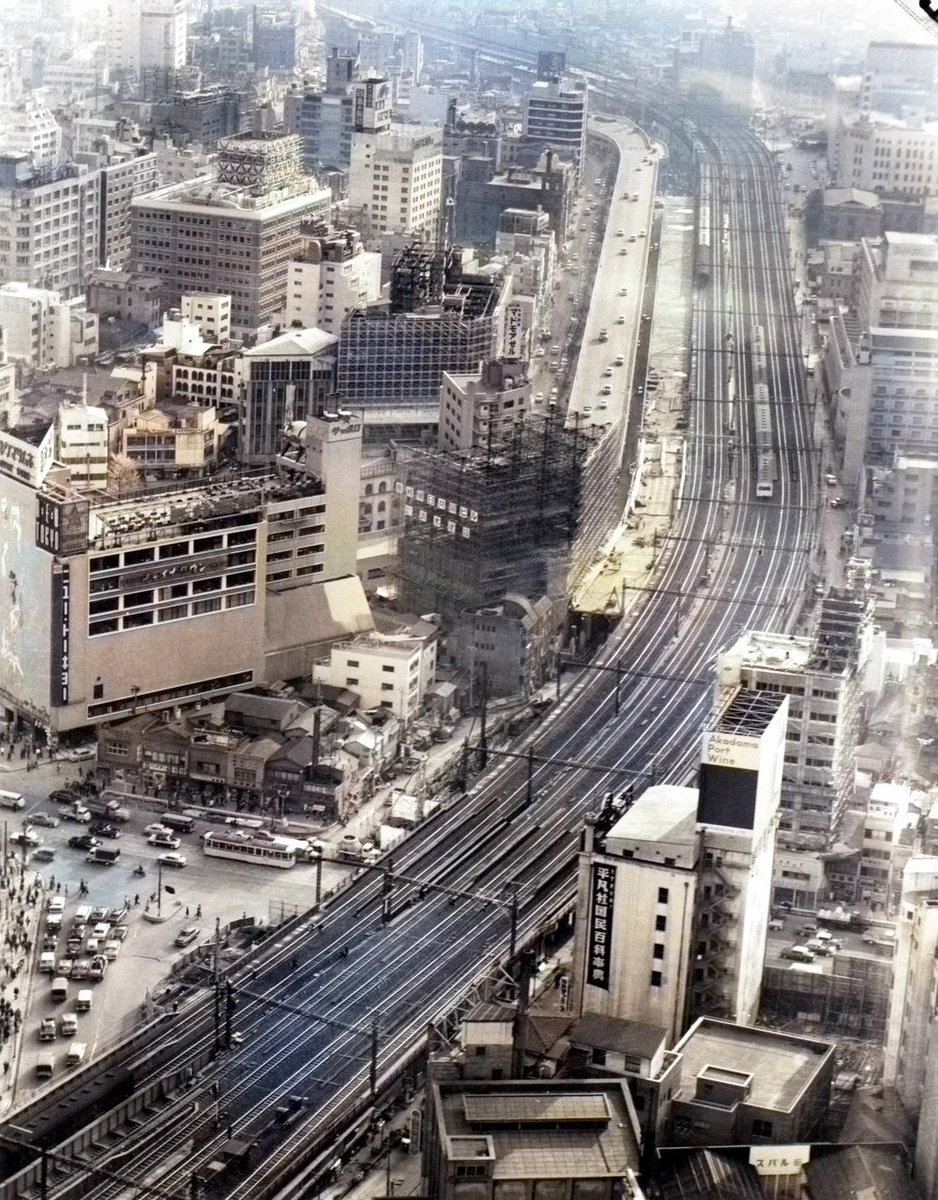
The part built course of the Tokaido Shinkansen between the present JNR tracks and the city’s new Metropolitan Expressway near Yurakucho Station. Source: Twitter

The New Tokaido Line viaduct being built along a narrow envelope through a dense cityscape. Yurakucho station, Tokyo, 1963. Source: Twitter
The land selected for the construction of the New Tokaido Line’s station in Tokyo had originally been intended for expansion of the conventional railway terminus itself. That never happened. Furthermore when the new Shinkansen to Tohoku, Joetsu, and other destinations was built, some of the conventional station’s platforms had to be given up in order to make space for a new Shinkansen terminus. It might surprise one that the Tokaido and the Joetsu for example are not connected up even though they use the same station. There’s many reasons for that including different operating practices and non standardisation of rolling stock for through trains.
Tokyo station once doubled as the original Shinkansen’s control centre facility. This was situated across a floor at the top of the original Shinkansen terminus. These days it is sited elsewhere at what is said to be a secret location, the reason being possible terrorism or other infraction that would seek to disrupt the entire Tokaido Shinkansen system.

Buildings being demolished just outside Tokyo station for the new railway. Source: Imgur

Construction of Tokyo station in 1963.

The construction of the Shinkansen section of Tokyo station showing the foundations of what would be the original terminus building and the signal control centre. Source: Asahi
Following are two quite different views of how Tokyo station was planned to look after the Shinkansen had been built. These plans first emerged in 1963 and were altered over time. The remodelling never happened and the original, historic, station buildings of 1914 are still a major part of the setting.

The tall building would have replaced the original station buildings entirely. Source: Koken-archi

A similar design to the previous. The huge tower has been modified and its base has some acknowledgement to the original station buildings. Source: Autohybridization57
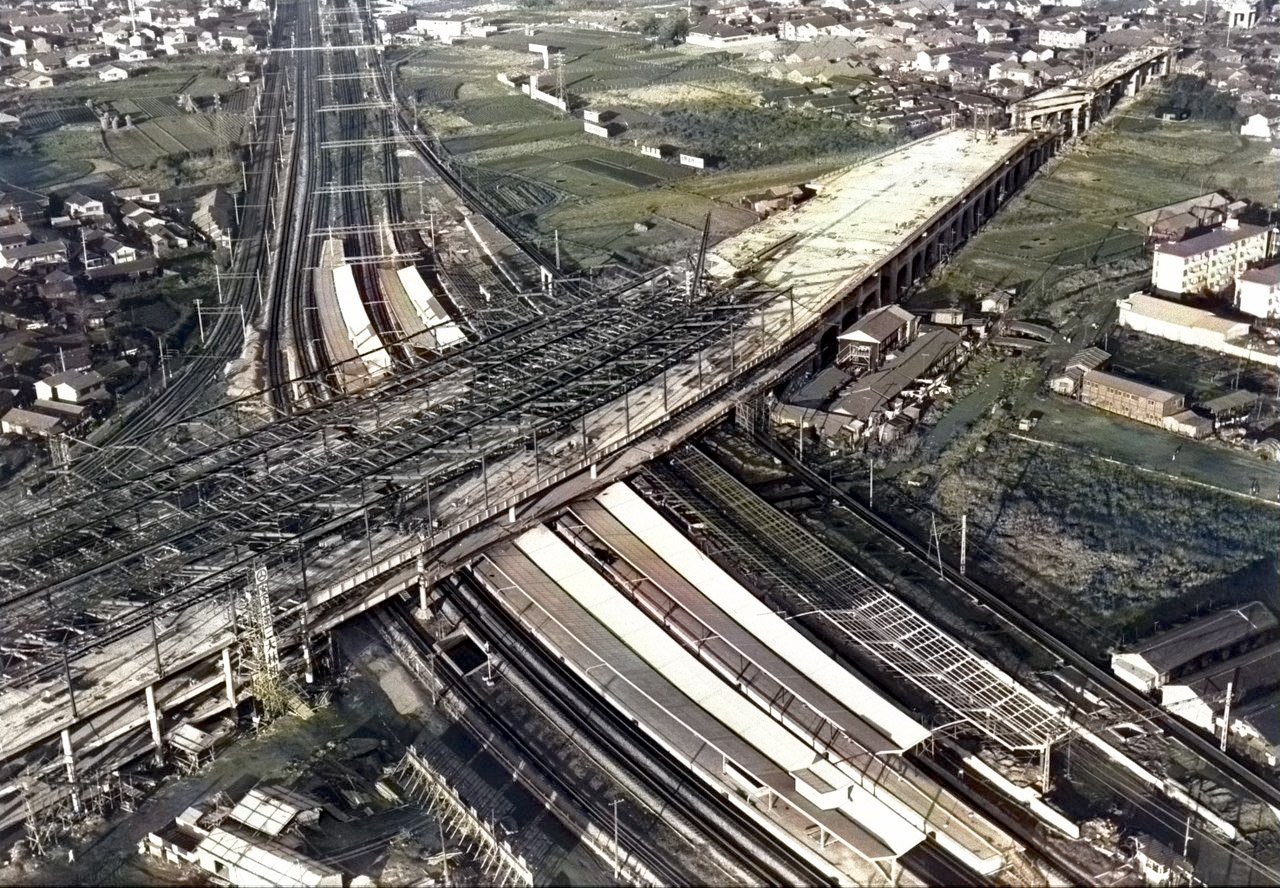
Shin-Osaka proceeding well. December 1963. Source: Twitter

Advert from 1963 showing the Yokogawa bridge under construction with Mount Fuji in the background.
Many people will know the first public trips on the Shinkansen began in October 1964, but few will even know the first public trains to operate on the new railway actually began in early 1963! Puzzled? Mystified by that claim? Its actually true and what’s more is many rail enthusiasts took the opportunity to ride the Shinkansen on these temporary public services in 1963. These services which actually used the new high speed railway clearly enabled many to enjoy the Shinkansen a year and half before the official opening in October 1964. We look at this in a later post!
Some more construction pictures of the Shinkansen
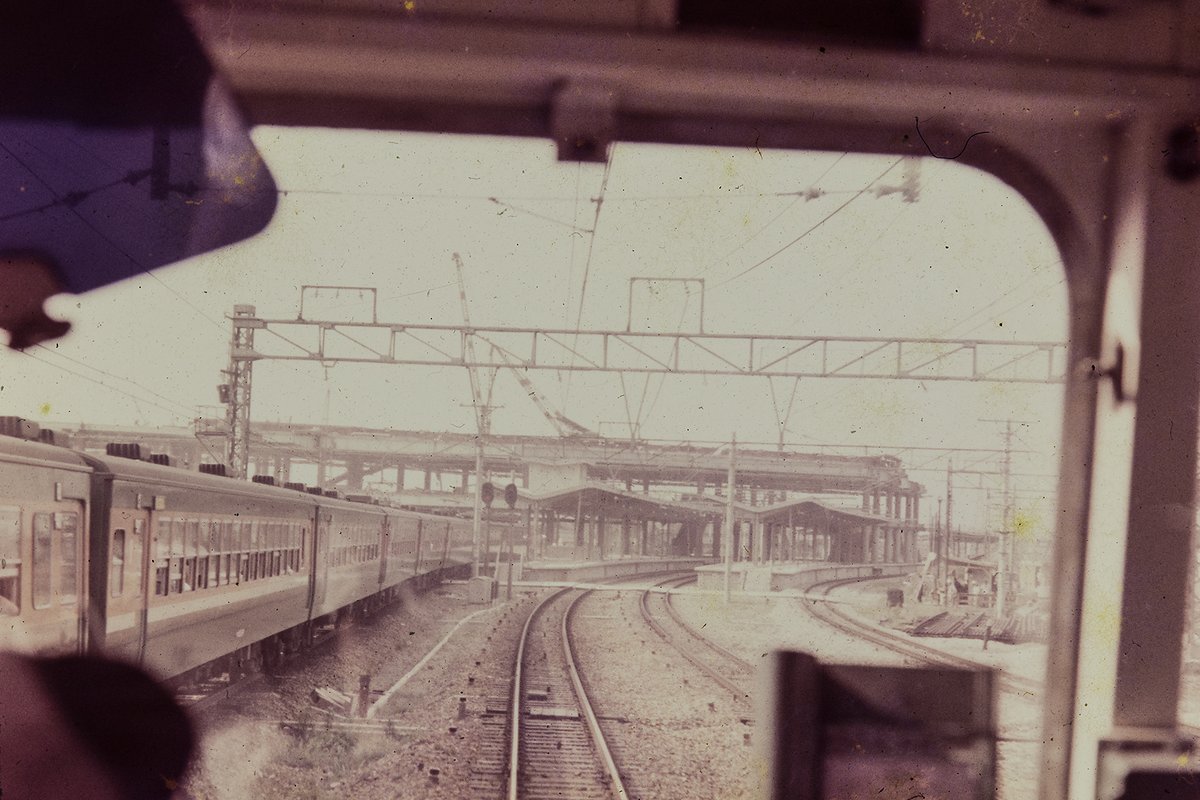
Early view of the new station at Shin-Osaka. The Shinkansen part’s only just begun construction at this stage whilst the the low level station (the narrow gauge) is quite well advanced. Source: Twitter
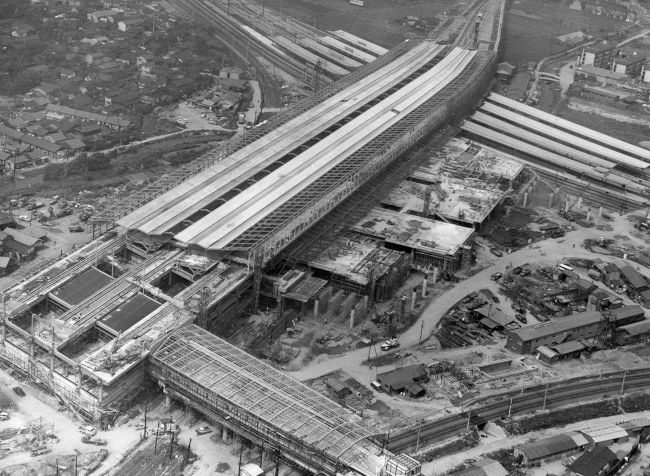
Partially complete Shin-Osaka station, probably early 1964. As mentioned earlier the site used once belonged to the Miyahara train yards. The conventional (narrow gauge) station is seen at the eastern end of the Shinkansen station whilst the Osaka metro’s station canbe seen at the bottom of the picture. Source: Twitter
Originally to be called Hajima as some pre 1964 maps show, Gifu-Hashima station is 112km from Osaka and 396km from Tokyo. It was the only other station to be built as a result of demands, and this was down to one particular couple. Their statue stands outside the station. Ōno Bamboku a local politician, and his wife, campaigned strongly for a station to be built in the locality. Originally there were to be none between Nagoya and Maibara.
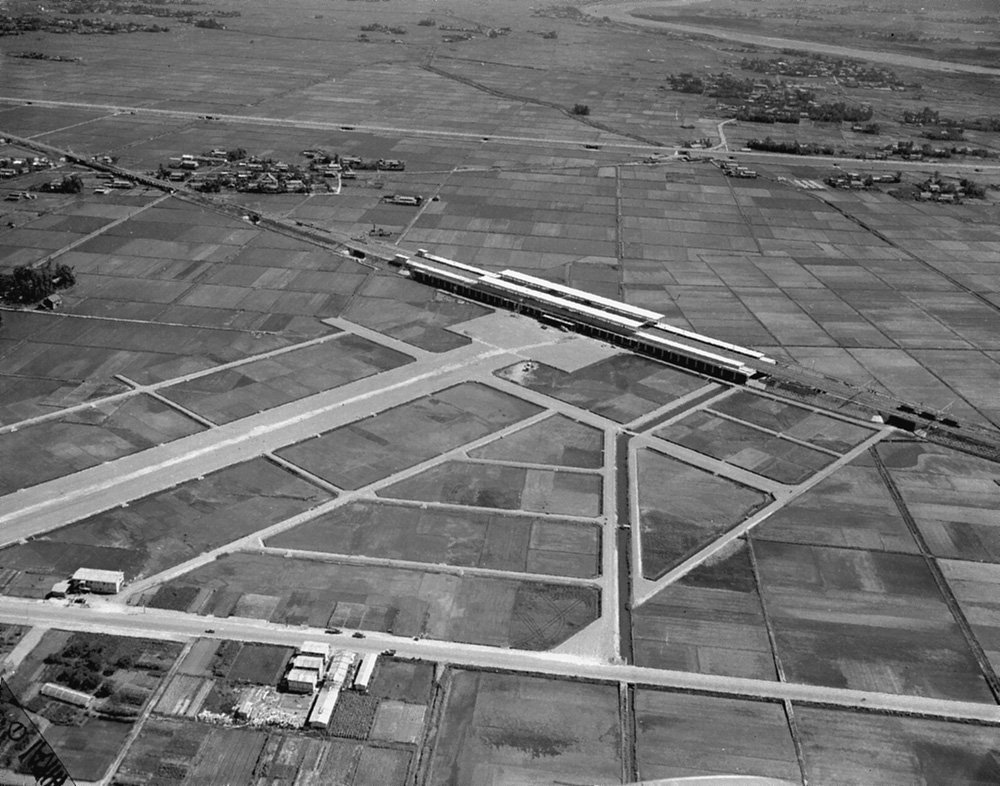
A part finished Gifu-Hashima station, which was described as a station built in the middle of a rice field. Source: Twitter
Gifu-Hashima is the only station on the Shinkansen to have a platform ‘0’. The station also has an unusual arrangement which consists of four platforms and a central pair of fast tracks. What is more unusual is the central tracks have their own cantenary masts (as opposed to a large span crossing all the tracks.)
The station is just before a snowy part of the country (where it does in fact snow quite a lot) which is the mountains between Gifu-Hashima and Maibara – and the larger than normal intermediate stop provides advantageous for many reasons – it will allow trackside crews to check trains as snow can damage trains at high speed, and clear snow that has compacted on the trains’ undersides, plus its also a facility in the rare case trains have to be turned round short of their destination because of snow or other natural phenomenon.
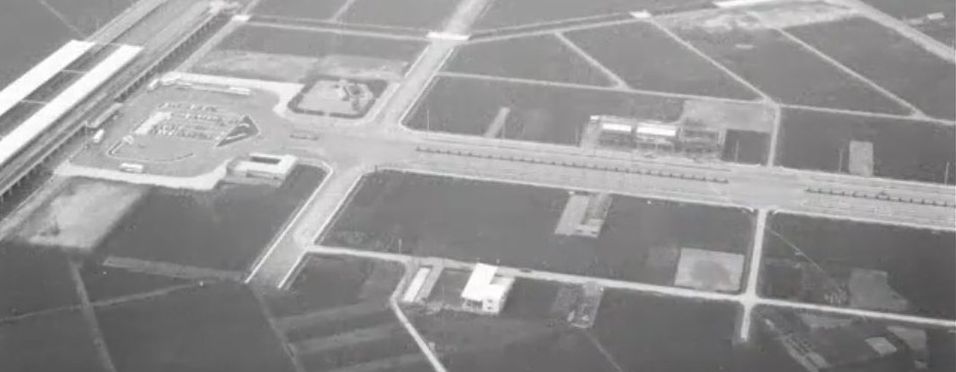
Gifu-Hashima, like a couple of other stations in the countryside well away from the centres, had splendid wide avenues leading up to them, which included oodles of car parking space! Source: Twitter
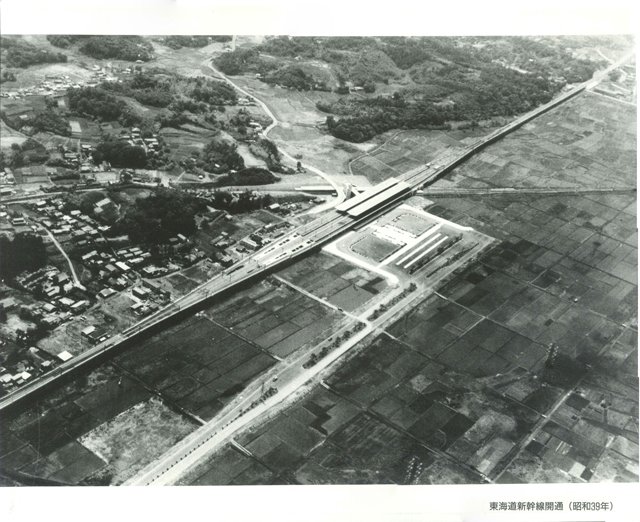
Shin-Yokohama. The substantial new roads leading to this station can also be seen. Source: Twitter
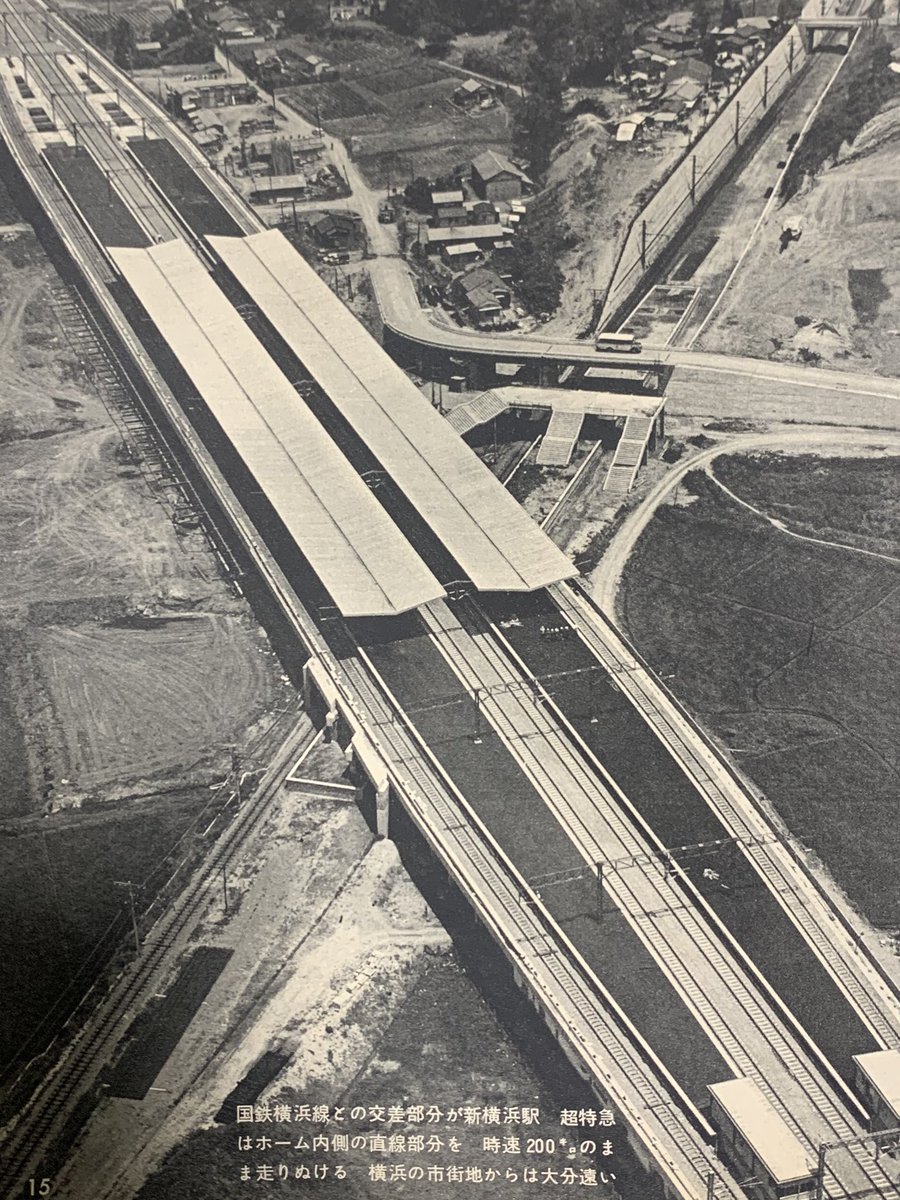
Shin-Yokohama is nearly completed 1964. Source: Twitter

The almost completed Shinkansen terminus at Osaka. Another with substantial approach roads. The long Hinode viaduct can be seen threading its way through Settsu City. Note the adjacent new station for the trains on Osaka’s metro. Source: Atamatote Blog
New Tanna Tunnel:
The Kajima Corporation built the western 4.9km of the 7.9km long New Tanna Tunnel. The company was appointed for this work based on its experience in building the original Tanna Tunnel.

Cross section of the new Tanna Tunnel showing the geological faults. Source: Geosociety Japan

Construction workers at the tunnel heading in the early sixties.

The roughly hewn bore of the New Tanna tunnel. Note the various methods of support including timber struts and steel framing.
These screencaps come from a video of the Shin-Tanna tunnel (partly produced by a British movie company) shows the construction of the New Tanna Tunnel between 1959 and 1962.)

Workers outside the tunnel portals. Scene from the same film.
Here’s some text on the presentation of that film I’ve just mentioned:
Bullet Railway New Tanna Tunnel Part 1 / Part 2 Hazama British movie company Part 1 Color 35 minutes Part 2 Color 23 minutes <Part 1> Since the construction of the Tokaido Shinkansen started in September 1959, it has been steadily proceeding with the attention of not only all the people but also the world railway world while creating many topics. In this construction plan, many large bridge works on the way, full-scale three-dimensional intersections, dozens of tunnel excavations and large works requiring advanced technology will be carried out in the past with a total length of about 600 粁. The biggest challenge is the construction of the new Tanna tunnel that runs through the mountains between Atami and Kannami. At the time of the original construction of the Tanna Tunnel, it is said that cows and horses pulled minecarts to carry out the remnants, and it is remembered how difficult the construction was. The Shin-Tanna Tunnel also challenges the complex strata surrounded by the Fire Mountains, pours new civil engineering machinery and advanced technology, leans to the limit of human intelligence, and obstacles such as large faults and spring water hot spring surplus soil. Construction is continuing while saying. The movie tries to convey the outline of the tunnel excavation method while depicting the efforts of working people. (Source: Hanabusa-Eigasha blog.)
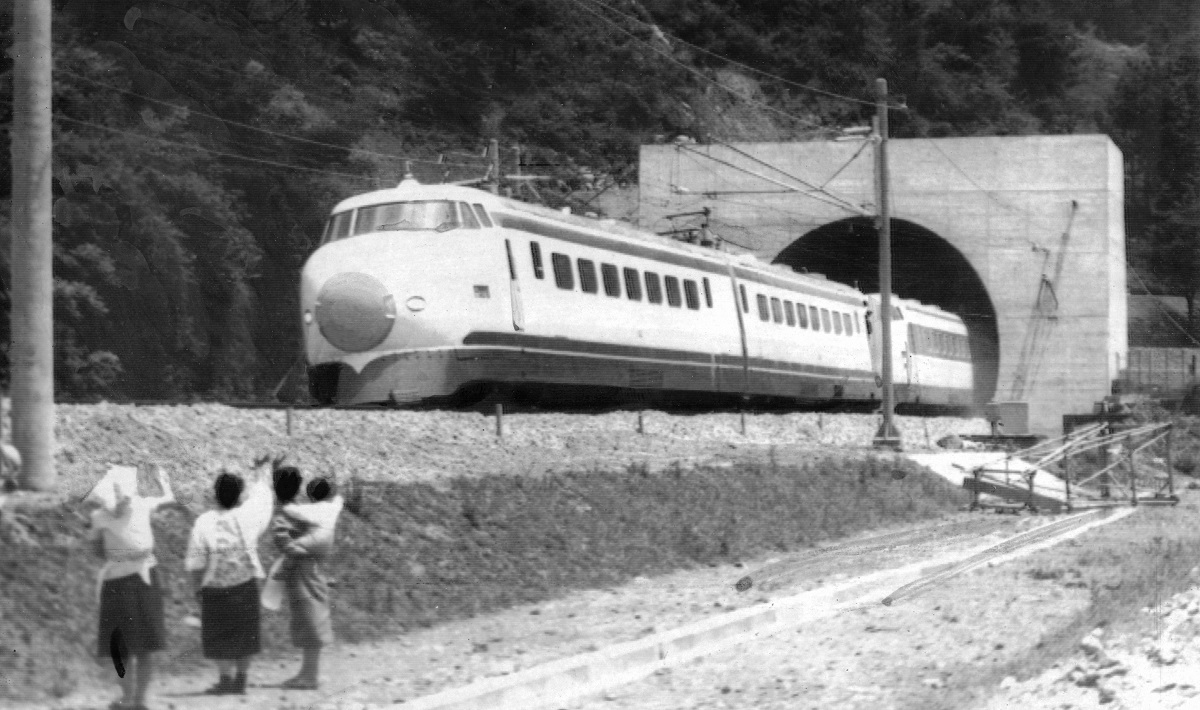
Rare picture showing the pair of prototype Shinaknsen test trains at the western portal of the New Tanna Tunnel, the event likely having taken place in either late 1963 or early 1964. Train testing no doubt had concluded by this time and the pair are likely being transferred to Torikai depot near Osaka. Source: Asahi
I was recently made aware of the following film on You Tube featuring both electric and steam traction on the classic Tokyo to Osaka line. Some of the New Tokiado Line locations (prior to its construction) can be seen in this film.
Other posts in the series:
The Tokaido Shinkansen (introduction)
The Tokyo to Osaka Line: A history #1
The Tokyo to Osaka Line: A history #2
The Tokyo to Osaka Line: A history #3
The Tokyo to Osaka Line: A history #4
The Tokyo to Osaka Line: A history #5
The last three (never published) are focused on specific aspects of the Tōkaidō Shinkansen:
The Tokyo to Osaka Line #6: Tunnels/Kozens/Hankyu

